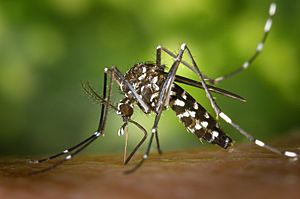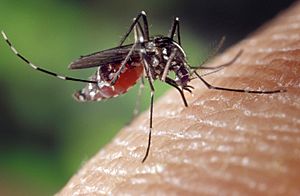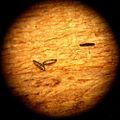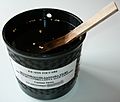Asian tiger mosquito facts for kids
Quick facts for kids Asian tiger mosquito |
|
|---|---|
 |
|
| Female at the start of feeding | |
| Scientific classification | |
| Kingdom: | |
| Phylum: | |
| Class: | |
| Order: | |
| Family: | |
| Subfamily: |
Culicinae
|
| Genus: | |
| Subgenus: | |
| Species: |
A. albopictus
|
| Binomial name | |
| Aedes albopictus (Skuse, 1894)
|
|
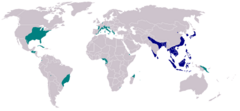 |
|
| Dark blue: Native range Dark green: introduced (as of December 2007) |
|
| Synonyms | |
|
Culex albopictus Skuse, 1894 |
|
The Asian tiger mosquito, also known as the forest day mosquito, is a type of mosquito. It originally comes from warm, wet areas in South-East Asia. You can spot it by its black and white striped legs and body.
This mosquito is usually between 2 and 10 millimeters long. Male Asian tiger mosquitoes are about 20% smaller than females. Over the past few decades, this mosquito has spread to many other countries. It often travels by hitching rides on transported goods.
Many people consider this mosquito a pest. Unlike many other mosquitoes, the Asian tiger mosquito often lives near humans. Other mosquitoes usually prefer wetlands. Another interesting fact is that this mosquito is active during the day. Most other mosquitoes only come out during dusk and dawn.
The Asian tiger mosquito can carry and spread several diseases. These include West Nile virus, Yellow fever virus, St. Louis encephalitis, dengue fever, and Chikungunya fever.
Contents
What Makes This Mosquito Special?
The Asian tiger mosquito is easy to recognize because of its striking white and black stripes. Its size can change depending on how many larvae are in the water and how much food they have. Because of this, the average adult mosquito is usually smaller than 10 millimeters.
Male mosquitoes are smaller than females, but they look quite similar. However, male mosquitoes have much bushier antennae. These antennae help them hear the female's buzzing sound.
One clear way to identify the Asian tiger mosquito is a single silvery-white line. This line starts between its eyes and goes down the top of its body. This unique stripe is the easiest and surest way to tell it apart.
Like other mosquitoes, the female has a long mouthpart called a proboscis. She uses this to collect blood, which she needs to produce her eggs. The Asian tiger mosquito bites very quickly. This makes it hard for people to swat it away! On the other hand, male mosquitoes mostly drink nectar from plants.
Female mosquitoes lay their eggs near water, but not directly in it. They often choose still water, like in a stagnant pool. However, they can lay eggs in any open container that holds water, even if it's just a tiny bit. They can also breed in slow-moving water. They often choose water sources near flowers. These mosquitoes do not fly very far, usually less than 200 meters. This means their breeding spots are likely close to where you find them.
It can be tricky to identify these mosquitoes correctly. The best way to be sure is to compare the mosquito you see with clear pictures of the Asian tiger mosquito.
What Do They Eat and How Do They Find Food?
Only female mosquitoes need blood to make their eggs. Both males and females also drink nectar and other sweet plant juices. To find a host, mosquitoes use several clues. They are attracted to carbon dioxide (which we breathe out) and other smells from a host. They also use humidity and what they see.
Mosquitoes search for a host in two steps. First, they fly around generally until they sense something from a host. Then, they fly directly towards it. Scientists use carbon dioxide and a mix of chemicals found on human skin to attract tiger mosquitoes to special traps.
The Asian tiger mosquito often bites in forests during the day. That's why it's also called the forest day mosquito. Their most active times can vary, but they usually rest in the morning and at night. They look for hosts both inside and outside homes, but they are especially active outdoors. The amount of blood they drink depends on their size, but it's usually very small. Their bites might not always hurt, but they are often more noticeable than bites from other mosquitoes. Tiger mosquitoes often bite a person more than once if they can.
Besides humans, Ae. albopictus also bites other mammals and birds.
Images for kids
-
Toxorhynchites speciosus larvae (an adult is shown here) eat the larvae of Aedes albopictus.
See also
 In Spanish: Mosquito tigre para niños
In Spanish: Mosquito tigre para niños


